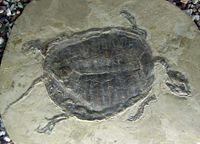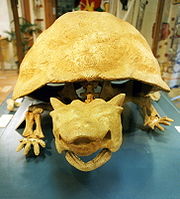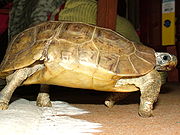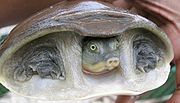
Cryptodira
Encyclopedia
Cryptodira is the taxonomic suborder of Testudines that includes most living tortoise
s and turtle
s. Cryptodira differ from Pleurodira
(side-neck turtles) in that they lower their necks and pull the heads straight back into the shells; instead of folding their necks sideways along the body under the shells' margins. They include among their species freshwater turtles, snapping turtles, tortoises, soft shell turtles, and sea turtles.
period, and by the end of the Jurassic had almost completely replaced Pleurodires in the lakes and rivers, while beginning to develop land-based species.
Cryptodira has three living superfamilies, the Chelonioidea (sea turtles), Testudinoidea
(tortoises and pond turtles) and Trionychoidea
(softshell turtles and relatives). The Kinosternoidea
are now recognized as a paraphyletic assemblage of mostly primitive Trionychoidea; they do not form a natural group.
There are two commonly-found circumscriptions of the Cryptodira. One is used here; it includes a number of primitive extinct lineages known only from fossil
s, as well as the Eucryptodira. These are, in turn, made up from some very basal groups, and the Centrocryptodira contains the prehistoric relatives of the living cryptodires, as well as the latter, which are collectively called Polycryptodira.
The alternate concept restricts the use of the term "Cryptodira" to the crown clade (i.e. Polycryptodira). The Cryptodira as understood here are called Cryptodiramorpha in this view. Under this approach, the pleurodires and cryptodires are not sister taxa.
As per the system used here, the Cryptodira can be classified as follows:
SUBORDER CRYPTODIRA




Tortoise
Tortoises are a family of land-dwelling reptiles of the order of turtles . Like their marine cousins, the sea turtles, tortoises are shielded from predators by a shell. The top part of the shell is the carapace, the underside is the plastron, and the two are connected by the bridge. The tortoise...
s and turtle
Turtle
Turtles are reptiles of the order Testudines , characterised by a special bony or cartilaginous shell developed from their ribs that acts as a shield...
s. Cryptodira differ from Pleurodira
Pleurodira
The Pleurodira are one of the two living suborders of turtles, the other being the Cryptodira. In many cases in the nomenclature of animals, ranks such as suborder are considered of little importance apart from nomenclatural or taxonomic reasons. However, this is not the case with the suborders of...
(side-neck turtles) in that they lower their necks and pull the heads straight back into the shells; instead of folding their necks sideways along the body under the shells' margins. They include among their species freshwater turtles, snapping turtles, tortoises, soft shell turtles, and sea turtles.
Systematics and evolution
Cryptodires evolved primarily through the JurassicJurassic
The Jurassic is a geologic period and system that extends from about Mya to Mya, that is, from the end of the Triassic to the beginning of the Cretaceous. The Jurassic constitutes the middle period of the Mesozoic era, also known as the age of reptiles. The start of the period is marked by...
period, and by the end of the Jurassic had almost completely replaced Pleurodires in the lakes and rivers, while beginning to develop land-based species.
Cryptodira has three living superfamilies, the Chelonioidea (sea turtles), Testudinoidea
Testudinoidea
Testudinoidea is a superfamily within the suborder Cryptodira of the order Testudines. It includes the families of pond turtles ; Asian turtles ; the Big-headed turtle and tortoises ....
(tortoises and pond turtles) and Trionychoidea
Trionychoidea
Trionychia is a superfamily of turtles which encompasses the species that are commonly referred to as softshelled turtles as well as some others. They are found throughout the temperate regions of the world....
(softshell turtles and relatives). The Kinosternoidea
Kinosternoidea
Kinosternoidea is a superfamily of aquatic turtles, which included two families: Dermatemydidae, and Kinosternidae.These are nowadays usually considered independent families of the Trionychia, among which they represent very plesiomorphic members which share a few peculiarly advanced traits...
are now recognized as a paraphyletic assemblage of mostly primitive Trionychoidea; they do not form a natural group.
There are two commonly-found circumscriptions of the Cryptodira. One is used here; it includes a number of primitive extinct lineages known only from fossil
Fossil
Fossils are the preserved remains or traces of animals , plants, and other organisms from the remote past...
s, as well as the Eucryptodira. These are, in turn, made up from some very basal groups, and the Centrocryptodira contains the prehistoric relatives of the living cryptodires, as well as the latter, which are collectively called Polycryptodira.
The alternate concept restricts the use of the term "Cryptodira" to the crown clade (i.e. Polycryptodira). The Cryptodira as understood here are called Cryptodiramorpha in this view. Under this approach, the pleurodires and cryptodires are not sister taxa.
As per the system used here, the Cryptodira can be classified as follows:
SUBORDER CRYPTODIRA
- Basal genera
- Genus †KayentachelysKayentachelysKayentachelys is an extinct genus of cryptodire turtle from the Early Jurassic Kayenta Formation of northern Arizona. Kayentachelys was approximately wide and in length. It lived in an environment dominated by streams and dunes....
(sometimes monotypicMonotypicIn biology, a monotypic taxon is a taxonomic group with only one biological type. The term's usage differs slightly between botany and zoology. The term monotypic has a separate use in conservation biology, monotypic habitat, regarding species habitat conversion eliminating biodiversity and...
family Kayentachelyidae) - Genus †Indochelys (sometimes monotypic family Indochelyidae)
- Genus †Kayentachelys

- †Infraorder ParacryptodiraParacryptodiraThe Paracryptodira are an extinct infraorder of the Testudines, an order of reptiles which includes tortoises, turtles and terrapins. Initially treated as suborder sister to the Cryptodira, they are now known to be a very primitive lineage inside the Cryptodira according to the most common use of...
- Basal and incertae sedisIncertae sedis, is a term used to define a taxonomic group where its broader relationships are unknown or undefined. Uncertainty at specific taxonomic levels is attributed by , , and similar terms.-Examples:*The fossil plant Paradinandra suecica could not be assigned to any...
- Family Kallokibotiidae
- Family Mongolochelyidae
- Family Pleurosternidae
- Family Solemydidae
- Superfamily Baenoidea
- Family BaenidaeBaenidaeBaenidae is an extinct family of cryptodiran turtles.-External links:* http://www.nhm.org/site/sites/default/files/dinosaur_institute/pdf/NHM_DI_proytecto_dino_Erika_Canola_Baenidae_Turtle_experience.pdf...
- Family Macrobaenidae
- Family Neurankylidae
- Family Baenidae
- Basal and incertae sedis



- Infraorder Eucryptodira
- Basal and incertae sedis
- Family †Eurysternidae
- Family †Plesiochelyidae
- Family †Xinjiangchelyidae
- CladeCladeA clade is a group consisting of a species and all its descendants. In the terms of biological systematics, a clade is a single "branch" on the "tree of life". The idea that such a "natural group" of organisms should be grouped together and given a taxonomic name is central to biological...
Centrocryptodira- †"Sinemys" wuerhoensis
- Genus †Chubutemys (Meiolaniidae?)
- Family †MeiolaniidaeMeiolaniidaeMeiolaniidae is an extinct family of large, possibly herbivorous turtles with heavily armored heads and tails. They are best known from the last surviving genus, Meiolania, which lived in the rainforests of Australia from the Oligocene until the Pleistocene, and relict populations that lived on...
- Genus †Osteopygis
- Family †Macrobaenidae (paraphyletic? May belong in Paracryptodira)
- Family †Sinemydidae (paraphyletic?)
- Genus †Judithemys
- Genus Hangaiemys ("Macrobaenidae"?)
- Clade Polycryptodira
-
- Family ChelydridaeChelydridaeChelydridae is a family of turtles which has seven extinct and two extant genera. The extant genera are Chelydra the snapping turtles, and its larger relative Macrochelys, of which the Alligator Snapping Turtle is the only species. Both are endemic to the Western Hemisphere...
(snapping turtles)
- Family Chelydridae
- Superfamily Chelonioidea (sea turtles)
- Family †ProtostegidaeProtostegidaeProtostegidae is a family of extinct marine turtles that lived during the Mesozoic Era. The family includes some of the largest sea turtles that ever existed. The largest, Archelon, had a head a meter long...
- Family †Thalassemyidae
- Family †Toxochelyidae
- Family CheloniidaeCheloniidaeCheloniidae is a family of turtles belonging to the sea turtle superfamily Chelonioidea.-Extant genera:*Genus Caretta**Loggerhead sea turtle *Genus Chelonia**Green sea turtle *Genus Eretmochelys...
(green sea turtles and relatives) - Family DermochelyidaeDermochelyidaeDermochelyidae is a family of turtles which has eight extinct and one extant genera.-Classification of known genera:*Subfamily Desmatochelyinae** Corochelys ** Desmatochelys *Subfamily Allopleuroninae ** Allopleuron ** Eosphargis...
(leatherback turtles)
- Family †Protostegidae
- Genus †Planetochelys
- Superfamily TestudinoideaTestudinoideaTestudinoidea is a superfamily within the suborder Cryptodira of the order Testudines. It includes the families of pond turtles ; Asian turtles ; the Big-headed turtle and tortoises ....
- Family †Haichemydidae
- Family †Lindholmemydidae
- Family †Sinochelyidae
- Family Platysternidae (big-headed turtle)
- Family EmydidaeEmydidaeEmydidae, commonly called the pond turtles or marsh turtles, is a family of turtles. Previously, several species of Asian box turtle were classified in the family. However, revised taxonomy has separated them to a different family. Now, Emydidae, with the exception of two species of pond turtle,...
(pondPond turtlePond turtle may refer to:* Emydidae, a family of pond turtles** Emys, a genus of Emydidae*** European pond turtle *** Sicilian pond turtle *** Western pond turtle...
, boxBox turtleThe box turtle , or box tortoise is a genus of turtle native to North America . The 12 taxa which are distinguished in the genus are distributed over four species. It is largely characterized by having a domed shell, which is hinged at the bottom, allowing the animal to close its shell tightly to...
and water turtles) - Family GeoemydidaeGeoemydidaeGeoemydidae is the largest and most diverse family in the order Testudines with about 70 species. It includes the Eurasian pond and river turtles and Neotropical wood turtles.-Characteristics:...
(Asian river turtles, Asian leaf turtleAsian Leaf TurtleThe Asian leaf turtle Cyclemys dentata is a species of turtle found in Southeast Asia. They are quite common in the pet trade with its carapace resembling that of a Cuora amboinensis hybrid.- Feeding :...
s, Asian box turtles and roofed turtles) - Family Testudinidae (tortoises)
- Superfamily Trionychia
- Family †Adocidae
- Family Carettochelyidae (pignose turtles)
- Family Dermatemydidae (river turtles)
- Family KinosternidaeKinosternidaeKinosternidae is a family of mostly small turtles that includes the mud turtles and musk turtles. The family Kinosternidae contains 25 species within 4 genera, but taxonomic reclassification is an ongoing process so many sources vary on the exact numbers of species and subspecies...
(mud turtles) - Family TrionychidaeTrionychidaeTrionychidae is a taxonomic family which comprises a number of turtle genera commonly known as softshells. They are also sometimes called pancake turtles. Softshells consist of some of the world's largest fresh water turtles, though many can adapt to living in highly brackish areas. Members of this...
(softshell turtles)
-
- Basal and incertae sedis

